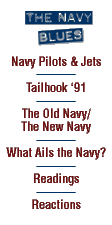
|


FRONTLINE Interview with
Admiral Stanley R. Arthur, USN (Ret.) former Vice Chief of Naval Operations and
Commander-in-Chief of Naval Forces during Operation Desert Storm
Q: What is it that makes a flyer? Is it something that the Navy teaches?
Is it something that God gives someone?
ARTHUR: The Navy can teach you to fly. But not everybody can learn to fly.
Everybody can learn to do a little bit of it. To do it at the level of
precision that it requires to be a military pilot, there has to be something
inside of you, first of all. And it's a very misunderstood skill. Some people
think that if you can fly an airplane, great. You can be a great officer. The
two are totally separate. You can be a great officer and a lousy pilot.
There's all combinations of this thing. But to be a good pilot, there has to
be-- Inside of you, a special little thing that nobody knows where it comes
from. We have all sorts of tests to predict, and they're pretty accurate. But
you would think that somebody that was very mechanically inclined would always
be a good pilot. That's not true. You'd think a great athlete would be a
natural to be a pilot. Not necessarily so.
Q: But what the Navy has to be good at is discerning whether or not its
aviators have that. How does it show itself?
ARTHUR: In the young stages of learning to fly an airplane, it shows itself first
of all by the retention factor: how well you learn from one flight to the next;
how well you retain that skill; how automatic does that skill become, once
you've mastered it. Is your automatic reflex to do it right or to do it wrong?
And so those are the things, as you're going through the training pipeline,
that the instructors look at. What's the retention? What happens when
stressed? Do they default to a solid position, or do they default to a
position of instability, where they're unsure of what action to take next, or
their maneuvers with the airplanes reflect this inability to really grasp the
situation? Do they retain the skill? Can they move that skill up to the next
level when required?
Q: You were shot off of the deck a lot of times, off of Vietnam. There was
at least one time, up near Danang, that you had an engine failure and you had
to wrestle the plane down. Tell me about that.
ARTHUR: We had been up on a bombing mission. And it was during one of the
offensives. I forget exactly the time frame now. But we were back in the back
corner of the border between North and South Vietnam and the Laos border, a
pretty hot little spot at the time. We'd completed our bombing runs, coming
off the target, I got a whiff of smoke in the cockpit, a smell. I took a look
around, and called my wing man and said, "There's something wrong here. I
think I've got oil fumes in the cockpit. Take a look at me to see if I've got
any holes." He took a look and said, "No, I don't. It doesn't look like
you've been hit. Your smoking out of your oil vent from the engine." I said,
"Okay. I think I've probably got an oil seal problem. We better head for
Danang." As we went sure enough, my oil level disappeared on me and oil
pressure started to get a little low, but it was still within limits. Making
the approach into Danang, the engine finally decided to give up the ghost. And
I got a couple real bad backfires out of it. He thought I was on fire. We
were over an overcast. I knew I was fairly close to the field, so I took a
dive through, and took a look. Now I was over the bay, and there were ammo
ships all over the place. So I had enough speed and altitude, and the engine
had quit, so went in and put it on the ground at Danang.
I was ready to come out of it until I saw where I was. There was no way of
predicting where the airplane would go. So as long as it was flying, I decided
to stay with it as long as I could.
Q: After the Gulf War has ended what were the challenges, the needs
perceived by the naval aviation community, even the junior officers, as those
needs and challenges filtered up to you. What did you hear?
ARTHUR: I felt that we had seen the last of the usefulness of the A-6 in a true
combat role; that it had become very vulnerable to modern day systems. The
programs that we'd had in place to be the replacement had floundered back here
in Washington. The old ATA which turned into the A-12, and the A-12 program
ran into trouble. And so the replacement for the A-6 was not coming on
schedule. And yet I felt that the A-6 had pretty much reached the end of its
useful life in a real hard combat role. Still a very capable airplane, and
certainly the people who were flying it and are still flying it today,
extraordinarily talented people. But we were going to take too many losses
with that airplane, if we ever got it-- hit into a major conflict again, it was
time to start moving and making-- putting pressure on the system to fix this
problem.
Our F-18 community acquitted itself well, but we found there were some
limitations to the F-18 if we were going to keep the airplane on our deck for a
long time. And consequently, the now continuing dialogue on the F-18--
Is it the right thing to do? I certainly thought it was. We needed to make a
little change in the survivability features for the F-18 and give it a little
bit more capability in all weather conditions and limited visibility
conditions.
So there was a little reconfiguration going on of our air wings, as a result
of what we learned in the conflict. And I think this brought a little
nervousness to the people, because obviously, when a community goes away, it's
pretty traumatic. And quite honestly, there had been nobody up through the
rank of captain in the aviation community by that time, who had ever seen a
community disappear. Naval aviation had been in such a stable mode for so long
that there were people who didn't realize--- in the middle of Vietnam and said,
"Hey, this airplane has outlived its usefulness in a combat role." We had all
these people who had never seen communities go away, and realize that you can
move from community. I have moved from community. I had moved from the ASW
carrier ASW community into the light attack community, back when I was a
lieutenant commander. But there were not many people around who could remember
those kinds of days. And so it was very unsettling.
Q: You'd moved from propeller planes into the jets. Were we into the
downsizing thing yet?
ARTHUR: We were into downsizing. We went into downsizing quite rapidly after
Desert Storm. And in fact, the Navy had been in a downsizing mode before that.
We had already started realizing that we were going to have to downsize. And
unlike especially the Army, which froze their downsizing during Desert Storm,
the Navy continued to make progress in downsizing. So we were still making
progress relative to where we thought we would be going. And then of course
that was fortuitous at the time, because the bottom-up review came along
shortly thereafter, which really put the pressure on to get sized correctly in
a hurry.
continued
|